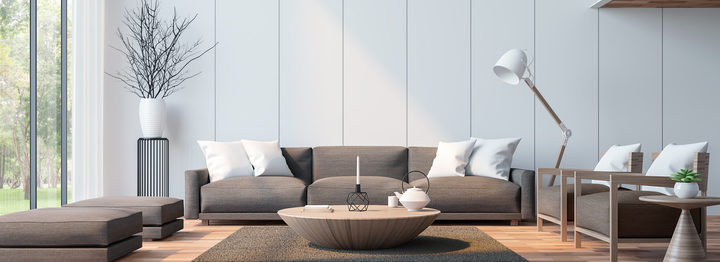
We live in a culture of excess. Our society is all about having more, buying the biggest, and doing as much as you can. It’s been this way for decades – arguably since the end of the Great Depression in the late 1930’s – so it only makes sense that people are finally becoming fatigued of the “more” mentality.
One of the byproducts of our cultural fatigue with having and doing more is the sudden surge in minimalist design, which establishes space for people to escape.
“To create that space, where we can truly relax, it helps to strip away the layers and to banish the excess clutter,” designer Janet Price says. “Minimalism is all about simplicity. Fewer things, more open space and natural light, and less fuss.”
Every personality responds differently to minimalism, but here are three of the biggest benefits of this design style:
There are enormous benefits to getting rid of junk and decluttering your living spaces. Not only does it provide mental relief from the stress and anxiety that “stuff” brings, but it could also improve your health. Knick-knacks collect dust and allergens, which can affect those with respiratory issues. Stripping away the excess may give your health a boost.
Square footage is expensive in this market. With minimalist design, there’s very little (if any) dead space, and you can make the most out of every room in your home.
Minimalism is a whole lot cheaper than living in excess. You don’t feel the need to fill every inch of wall and floor space with furniture, items, and accessories. Instead, you can focus on quality over quantity.
It’s hard to argue with a design style that rids your home of junk, makes more out of the space you already have, and lowers your expenses. If you’ve never given it serious consideration, now may be the time.
It seems simple from the outside looking in but achieving a truly minimalist design isn’t as easy as you might think. It requires some serious purpose and effort. Here are some tips for achieving a design that both looks good and feels good:
Unless you’re getting ready to move into a new house, you don’t have the luxury of attacking everything at once. The best way to go from cluttered to minimalist is to take things one room at a time.
Start with the living spaces you use most – such as the kitchen, living room, bedroom, and home office. Move through these rooms one by one and the idea of simplifying will get easier and easier. This process could take months, so have patience.
One of the quickest ways to make a space look cluttered and busy is to use lots of different colors. Minimalist design requires a tight, simple color palette that consists of just two or three tones within the same color family.
Whites and greys are really popular right now, but you can go with whatever your eye desires. Just make sure you’re consistent with your selections, or else you’ll risk introducing unnecessary distractions.
“Keep everything in your color palette, but having all your finishes being really smooth and slick can feel cold, so bring in linens, wools, wovens in your textiles and pottery, clay, porcelain in your accessories,” designer Jaime Derringer writes. “Keep the color palette quiet, but the texture still needs to be there for it to look inviting and not like a showroom. Anything handmade is an extra plus.”
If you’re going for modern minimalism, concrete, steel, and other industrial materials work well. For a more rustic or classic look, try reclaimed wood and other natural elements. Plants and greenery introduce unique texture that works with any style.
One of the biggest challenges you’ll face in your pursuit of minimalism is keeping surfaces clean. This is especially difficult with kitchen countertops, which quickly fill up with stuff.
“Small appliances hardly feel small when they’re taking up all of your available kitchen counter space. Limit that real estate to small appliances you use every single day without fail, and store everything else in cupboards,” designer Laura Gaskill advises.
Other problem areas to keep an eye out for include the kitchen table, coffee table, and any hard surfaces near entryways.
Nothing is random in minimalist design. If you’re going to introduce something into your home, it needs somewhere to go. Having a place for everything ensures that nothing gets too cluttered.
In minimalist design, you don’t have room for things you don’t use. Virtually anything you include in your home should have a purpose and function—whether it’s something you sit on, use for storage, or use to accomplish a particular task. This means no tables collecting dust in a corner or seating that never gets used.
Every so often – perhaps once every three or four months – go around your house and take inventory of the items you have. Think back to the last time each item was used. If it’s been longer than a year, consider getting rid of it. This regular act of purging will keep your design practical and functional.
Perhaps you’re tired of living with 5,000 square feet when you really only need 2,500? Maybe you’re looking for a more energy efficient home in the suburbs rather than a dated loft in the city? Whatever the case may be, we can help you sell your home. We can also help you keep more of your hard-earned equity.
At Green Residential, we don’t take the typical three percent seller’s agent commission. Instead, we work on a flat fee commission that saves our clients thousands of dollars at the closing table. For more information on how we can help you, please reach out
